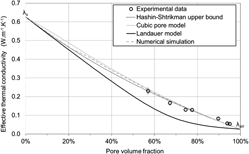Crossref Citations
This article has been cited by the following publications. This list is generated based on data provided by
Crossref.
De Marcos, Anthony
Naït-Ali, Benoit
Tessier-Doyen, Nicolas
Alzina, Arnaud
Pagnoux, Cécile
and
Peyratout, Claire S.
2014.
Influence of the ice front velocity and of the composition of suspensions on thermal properties of bentonite materials prepared using freeze–casting process.
Journal of the European Ceramic Society,
Vol. 34,
Issue. 16,
p.
4433.
Li, Fei
Kang, Zhuang
Huang, Xiao
Wang, Xin-Gang
and
Zhang, Guo-Jun
2014.
Preparation of zirconium carbide foam by direct foaming method.
Journal of the European Ceramic Society,
Vol. 34,
Issue. 15,
p.
3513.
2014.
Porous Materials.
Journal of the Japan Society for Technology of Plasticity,
Vol. 55,
Issue. 643,
p.
753.
Borchardt, Lars
Michels, Nina-Luisa
Nowak, Torsten
Mitchell, Sharon
and
Pérez-Ramírez, Javier
2015.
Structuring zeolite bodies for enhanced heat-transfer properties.
Microporous and Mesoporous Materials,
Vol. 208,
Issue. ,
p.
196.
Cao, Wei
Cheng, Xudong
Gong, Lunlun
Li, Ye
Zhang, Ruifang
and
Zhang, Heping
2015.
Thermal conductivity of highly porous ceramic foams with different agar concentrations.
Materials Letters,
Vol. 139,
Issue. ,
p.
66.
Kurosaki, Ken
Umeda, Akira
Kumagai, Masaya
Ohishi, Yuji
Muta, Hiroaki
and
Yamanaka, Shinsuke
2015.
Microstructure and Thermal Conductivity of RuAl<sub>2</sub> Prepared by a Single-Roll Melt-Spinning Method.
Journal of the Japan Institute of Metals,
Vol. 79,
Issue. 11,
p.
573.
Bourret, J.
Tessier-Doyen, N.
Guinebretiere, R.
Joussein, E.
and
Smith, D.S.
2015.
Anisotropy of thermal conductivity and elastic properties of extruded clay-based materials: Evolution with thermal treatment.
Applied Clay Science,
Vol. 116-117,
Issue. ,
p.
150.
Kim, Kyowon
and
Murphy, Thomas E.
2015.
Strong anisotropic thermal conductivity of nanoporous silicon.
Journal of Applied Physics,
Vol. 118,
Issue. 15,
Klobes, B.
Bessas, D.
Juranyi, F.
Görlitz, H.
Pacheco, V.
and
Hermann, R. P.
2015.
Effect of nanocrystallinity on lattice dynamics in Bi2Te3based thermoelectrics.
physica status solidi (RRL) - Rapid Research Letters,
Vol. 9,
Issue. 1,
p.
57.
Belmoujahid, Yassine
Bonne, Magali
Scudeller, Yves
Schleich, Donald
Grohens, Yves
and
Lebeau, Bénédicte
2015.
Thermal conductivity of monolithic assemblies of SBA-15 ordered mesoporous silica particles.
Microporous and Mesoporous Materials,
Vol. 201,
Issue. ,
p.
124.
Petersen, Rasmus R.
König, Jakob
and
Yue, Yuanzheng
2015.
The mechanism of foaming and thermal conductivity of glasses foamed with MnO 2.
Journal of Non-Crystalline Solids,
Vol. 425,
Issue. ,
p.
74.
Al Nasiri, Nasrin
Patra, Niranjan
Horlait, Denis
Jayaseelan, Daniel Doni
Lee, William E.
and
Smialek, J.
2016.
Thermal Properties of Rare‐Earth Monosilicates for EBC on Si‐Based Ceramic Composites.
Journal of the American Ceramic Society,
Vol. 99,
Issue. 2,
p.
589.
Chang, Boyce
Zhong, Landi
and
Akinc, Mufit
2016.
Low cost composites for vacuum insulation core material.
Vacuum,
Vol. 131,
Issue. ,
p.
120.
Hautcoeur, D.
Lorgouilloux, Y.
Leriche, A.
Gonon, M.
Nait-Ali, B.
Smith, D.S.
Lardot, V.
and
Cambier, F.
2016.
Thermal conductivity of ceramic/metal composites from preforms produced by freeze casting.
Ceramics International,
Vol. 42,
Issue. 12,
p.
14077.
Becker, Henning
Güttel, Robert
and
Turek, Thomas
2016.
Enhancing internal mass transport in Fischer–Tropsch catalyst layers utilizing transport pores.
Catalysis Science & Technology,
Vol. 6,
Issue. 1,
p.
275.
Zouaoui, Mouna Jabli
Nait-Ali, Benoit
Glandut, Nicolas
and
Smith, David S.
2016.
Effect of humidity on the dielectric constant and electrical impedance of mesoporous zirconia ceramics.
Journal of the European Ceramic Society,
Vol. 36,
Issue. 1,
p.
163.
Diallo, Mouhamad S.
Srinivasan, Srilok
Chang, Boyce
Ghosh, Suvojit
and
Balasubramanian, Ganesh
2016.
Effect of metallic nanoparticle fillers on the thermal conductivity of diatomaceous earth.
Physics Letters A,
Vol. 380,
Issue. 43,
p.
3645.
Sokołowski, Paweł
Pawłowski, Lech
Dietrich, Dagmar
Lampke, Thomas
and
Jech, David
2016.
Advanced Microscopic Study of Suspension Plasma-Sprayed Zirconia Coatings with Different Microstructures.
Journal of Thermal Spray Technology,
Vol. 25,
Issue. 1-2,
p.
94.
Zhou, Hongju
Deng, Hua
Zhang, Li
Wu, Zhiqiang
Deng, Sha
Yang, Weixing
Zhang, Qin
Chen, Feng
and
Fu, Qiang
2016.
Toward multi-functional polymer composites through selectively distributing functional fillers.
Composites Part A: Applied Science and Manufacturing,
Vol. 82,
Issue. ,
p.
20.
Laureto, John
Tomasi, Julie
King, Julia A.
and
Pearce, Joshua M.
2017.
Thermal properties of 3-D printed polylactic acid-metal composites.
Progress in Additive Manufacturing,
Vol. 2,
Issue. 1-2,
p.
57.



